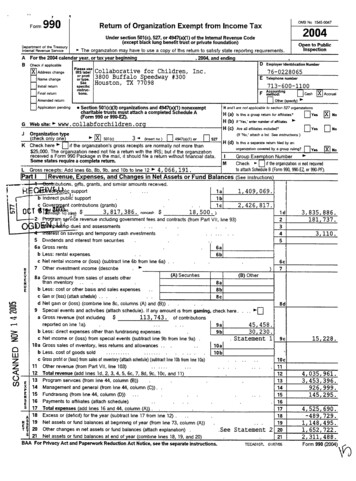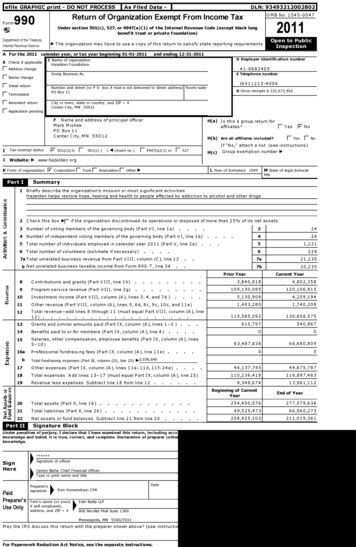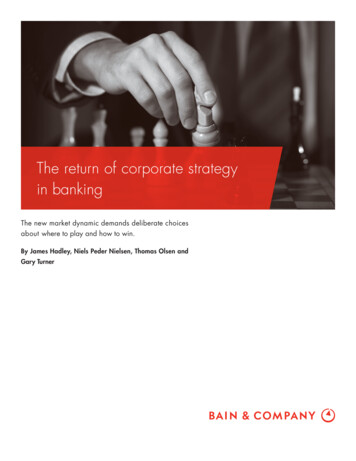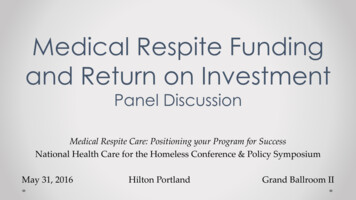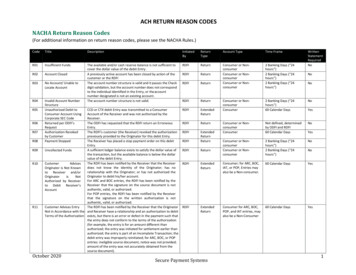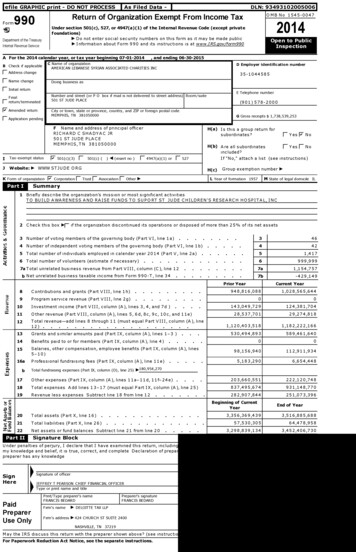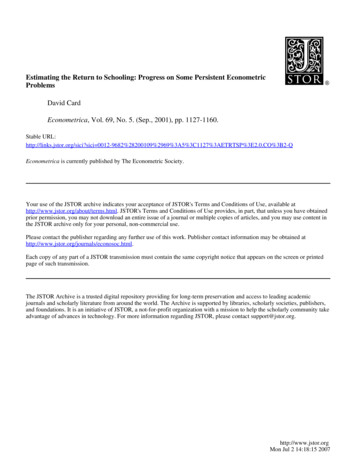
Transcription
Estimating the Return to Schooling: Progress on Some Persistent EconometricProblemsDavid CardEconometrica, Vol. 69, No. 5. (Sep., 2001), pp. 1127-1160.Stable URL:http://links.jstor.org/sici?sici CO%3B2-QEconometrica is currently published by The Econometric Society.Your use of the JSTOR archive indicates your acceptance of JSTOR's Terms and Conditions of Use, available athttp://www.jstor.org/about/terms.html. JSTOR's Terms and Conditions of Use provides, in part, that unless you have obtainedprior permission, you may not download an entire issue of a journal or multiple copies of articles, and you may use content inthe JSTOR archive only for your personal, non-commercial use.Please contact the publisher regarding any further use of this work. Publisher contact information may be obtained athttp://www.jstor.org/journals/econosoc.html.Each copy of any part of a JSTOR transmission must contain the same copyright notice that appears on the screen or printedpage of such transmission.The JSTOR Archive is a trusted digital repository providing for long-term preservation and access to leading academicjournals and scholarly literature from around the world. The Archive is supported by libraries, scholarly societies, publishers,and foundations. It is an initiative of JSTOR, a not-for-profit organization with a mission to help the scholarly community takeadvantage of advances in technology. For more information regarding JSTOR, please contact support@jstor.org.http://www.jstor.orgMon Jul 2 14:18:15 2007
Economettica, Vol. 69, No. 5 (September, 20011, 1127-1160ESTIMATING T H E RETURN T O SCHOOLING: PROGRESSON SOME PERSISTENT ECONOMETRIC PROBLEMSThis paper reviews a set of recent studies that have attempted to measure the causaleffect of education on labor market earnings by using institutional features of the supplyside of the education system as exogenous determinants of schooling outcomes. A simpletheoretical model that highlights the role of comparative advantage in the optimalschooling decision is presented and used to motivate an extended discussion of econometric issues, including the properties of ordinary least squares and instrumental variablesestimators. A review of studies that have used compulsoiy schooling laws, differences inthe accessibility of schools, and similar features as instrumental variables for completededucation, reveals that the resulting estimates of the return to schooling are typically asbig or bigger than the corresponding ordinaly least squares estimates. One interpretationof this finding is that marginal returns to education among the low-education subgroupstypically affected by supply-side innovations tend to be relatively high, reflecting their highmarginal costs of schooling, rather than low ability that limits their return to education.KEYWORDS:Returns to education, ability bias, random coefficientsOVERTHE PAST DECADE there has been a resurgence of interest in the study ofthe causal links between education and labor market success. Part of thisrenewed interest stems from a rise in the "return" to education, especially in theU.S. labor market, and a search for the causes of the growing disparitiesbetween more and less-educated workers (Katz and Autor (1999)). Part isattributable to the revival of interest in the determinants of economic growth,and a new focus on the role of human capital in the development process (Tope1(1999)). Finally, many countries are experiencing rapid growth in their secondaryand post-secondary school enrollment rates, leading to a concern about therelative costs and benefits of higher education for those who were not previouslyreceiving it.In addition to the stimulus provided by these key substantive issues, interestin the joint structure of education and earnings has been heightened by thebelief that some progress has been made-and more may follow-in the verydifficult task of uncovering the causal effect of education in labor marketoutcomes. The basic idea underlying this new thrust of research is that institutional features of the education system can be used to form credible instrumental variables for individual schooling outcomes that can cut through the GordianKnot of endogenous schooling and unobserved ability. The use of supply-sidevariables to help resolve identification problems on the demand side of theI .Fisher-Schultz Lecture delivered to the European Meeting of the Econometric Society, September, 1998. I am grateful to Joshua Angrist, Michael Boozer, Ken Chay, Andrew Hildreth, AlanKrueger, and a co-editor for comments on earlier versions of this material, and to James Powell forhelpful discussions.
1128DAVID CARDeducation market is a natural outgrowth of standard econometric practice.Nevertheless, the idea attracted very little attention in the first wave of microeconometric studies of education and earnings in the 1960's and 1970's. Indeed, itis one of the few methodological issues that is not discussed thoroughly inGriliches' (1977) landmark survey of the first-wave literature.In this paper, I present a survey and partial synthesis of the recent literaturethat has used "supply-side" features of the education system to help identify thecausal effect of education. In interpreting this literature I believe it is helpful towork from a theoretical and econometric viewpoint that explicitly recognizes thepossibility that returns to education may vary across the population, dependingon such characteristics as family background and ability. This perspective helpsto reconcile various findings in the literature, and also provides a usefulframework for generating new hypotheses and insights about the connectionbetween education and earnings.The paper begins with the presentation of a simple theoretical model ofendogenous schooling. This model is then used to motivate an extended discussion of various econometric issues. Finally, I present a selective review of therecent literature on estimating the economic returns to education, drawing onstudies of the U.S. and other developed economies, as well as a handful ofstudies of developing economies.1. AMODEL O F ENDOGENOUS SCHOOLINGMost of the conceptual issues underlying the interpretation of recent studiesof the return to education can be illustrated in the framework of a simple modelthat builds on Becker (1967). In such a model individuals face a marketopportunity locus that gives the level of earnings associated with alternativeschooling choices, and reach an optimal schooling decision by balancing thebenefits of higher schooling (which are reaped over the lifecycle) against thecosts (which are born early on). Traditionally, it is assumed that individuals seekto maximize the discounted present value of earnings, net of schooling costs(see, e.g., Willis (1986)). This is appropriate if people can borrow or lend at afixed interest rate, and if they are indifferent between attending school orworking during their late teens and early twenties. More generally, however,different individuals may have different aptitudes and tastes for schoolingrelative to work, and this variation may lead to differences in the optimal levelof schooling across individuals.Assume that individuals have an infinite planning horizon that starts at theminimum school-leaving age (t 0) and that they accrue a flow of utility inperiod t that depends on consumption c(t) in period t and on whether they arein school (and working part time) or out of school and working full time. Utilitywhile in school is u(c(t)) - (t) and utility out of school is u(c(t)), where 4 . 1 isan increasing concave function and (t) is a convex function that reflects the
RETURN TO SCHOOLING1129relative disutility of school versus work for the tth year of schooling.' Finally,assume that individuals discount future utility flows at a subjective discount ratep, and make a once-for-all decision on when to leave c h o o l Lifecycle. utility,conditional on schooling S and a given consumption profile isLet y(S, t) denote real earnings at age t of an individual who has completed Syears of post-compulsory schooling (with t 2 S 2 o ) . Assume that individualswho are in school at time t work part time and earn p(t), and pay tuition costsof T(t). Moreover, assume that the individual can borrow or lend freely at afixed interest rate R. Under these conditions the intertemporal budget constraint isAn individual's optimal schooling choice and optimal consumption pathmaximizeThe derivative of this expression with respect to S iswhere'1n principle 4(S) can be negative (if schooling is preferred to work) or positive. For simplicity Iam treating hours of work both during and after the completion of school as exogenous.3 a r da nd Lemieux (2000) examine school-leaving behavior of young men and women in theNational Longitudinal Survey of Youth and find that about one quarter of those who leave schoolreturn at some point in the future. However, more than half of the returners complete one semesteror less of additional schooling. Angrist and Newey (1991) study the earnings changes associated witheducation increments acquired after young men first enter the labor market on a full-time basis.4 h earnings function y(S,t) may reflect productivity and/or signaling effects or higherschooling. As noted below, some recent studies identify the causal effect of education by comparingschooling and earnings differences across cohorts or other groups. In the presence of signalingeffects the "returns" to schooling estimated in this way may differ from the earnings gains expectedby any given individual in the group.
1130DAVID CARDrepresents the marginal benefit of the Sth unit of schooling (expressed in periodS dollars), andMC(S) y ( S , S ) - y ( S ) T(S) l / e - ( " ) ' ( )represents the marginal cost of the Sth unit of schooling (also in period Sdollars). Notice that if (S) 0, then MC(S) is independent of preferences anddepends only on the net opportunity cost of schooling (y(S, S ) -p(S)) plustuition costs (T(S)). Otherwise, MC(S) also includes a term capturing therelative disutility of school versus work.Assuming that MC(S) rises faster than MB(S), a necessary and sufficientcondition for an optimal schooling choice is that MC(S) MB(S). To proceed,assume that log earnings are additively separable in education and years ofpost-schooling experience (Mincer (1974)). Then the earnings function can bewritten as y(S, t) f(S)h(t - S ) (with h(0) I), and the marginal benefit of theSth unit of schooling isMB(S) f' ( ) / h ( r ) e " d r ' ( s ) H ( R ) ,0where H ( R ) is a decreasing function of the interest rate. In particular, ifearnings are fixed after the completion of schooling (i.e., h(t) 1 for all t) thenH ( R ) 1/R. More generally, if earnings follow a concave lifecycle profile, thenH ( R ) 1/(R -g), where g is the constant growth rate that is "equivalent" tothe lifecycle profile (i.e. /reg' X e - R ' d /,"h(r)epR'dr).Under separability, the marginal costs and marginal benefits of additionalschooling are equated whenThe left-hand side of this expression is the proportional increase in earnings(per year) associated with the Sth unit of schooling. The right-hand side is theannuitized marginal cost of the Sth unit of schooling, expressed as a fraction offoregone earnings. Ignoring tuition costs and earnings while in school, and anydisutility of schooling relative to work, and assuming that earnings are fixed overthe lifecycle, this expression reduces to the well-known condition f '(S)/f(S) R(see, e.g., Willis (1986)), which implies that individuals invest in schooling untilthe marginal return is equal to the interest rate.To consider a more general case, assume that u(c(t)) log c(t). Then the firstorder conditions for an optimal consumption profile, together with the lifecyclebudget constraint, imply thatwhere W(S) is the value of lifecycle wealth associated with the schooling choiceS. Assume further that part-time earnings while in school are approximately
RETURN TO SCHOOLING1131equal to tuition costs (i.e., T(S) y(S)). Then an optimal schooling choicesatisfies the conditionRelative to the baseline case that ignores preferences for school versus workand post-schooling earnings growth, this expression introduces two additionalconsiderations to the determination of optimal schooling. First, the interest ratemust be adjusted to reflect lifecycle earnings growth. Second, marginal cost hasto account for the relative disutility of attending the Sth year of c h o o l i n g . Inspection of equation (1) suggests that individual heterogeneity in theoptimal schooling choice can arise from one of two sources: differences in theeconomic benefits of schooling, represented by heterogeneity in the marginalreturn to schooling f '(S)/f(S); or differences in the marginal costs of schooling,represented by heterogeneity in d(S). A simple specification of these heterogeneity components iswhere b, and r, are random variables with means b and ? and second momentsa;, q2,a nd a,., and 12, and k , are nonnegative constants."heseassumptionsimply that the optimal schooling choice is linear in the individual-specificheterogeneity terms:where k 12, 12, is assumed to be strictly positive.At the equilibrium level of schooling described by equation (4) individual i'smarginal return to schooling isThis model gives rise to a nondegenerate distribution of marginal returns acrossthe population unless one of two conditions is satisfied: k , 0 and vi ? for all'A more complex expression arises if part time earnings while in school do not fully offset tuition.For example, if tuition costs and part time earnings are constant ( T ( t ) T ;y ( t ) p ) , it can beshown thatIf tuition costs are small relative to lifetime earnings, the term in square brackets is close to 1,implying6 o t thate if individuals are indifferent between scho
1128 DAVID CARD education market is a natural outgrowth of standard econometric practice. Nevertheless, the idea attracted very little attention in the first wave of microe- conometric studies of education and earnings in the 1960's and 1970's. Indeed, it






